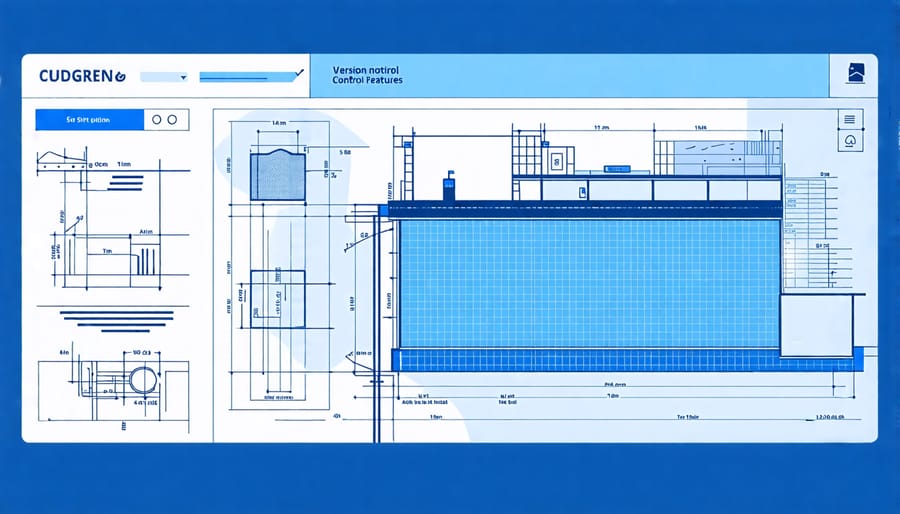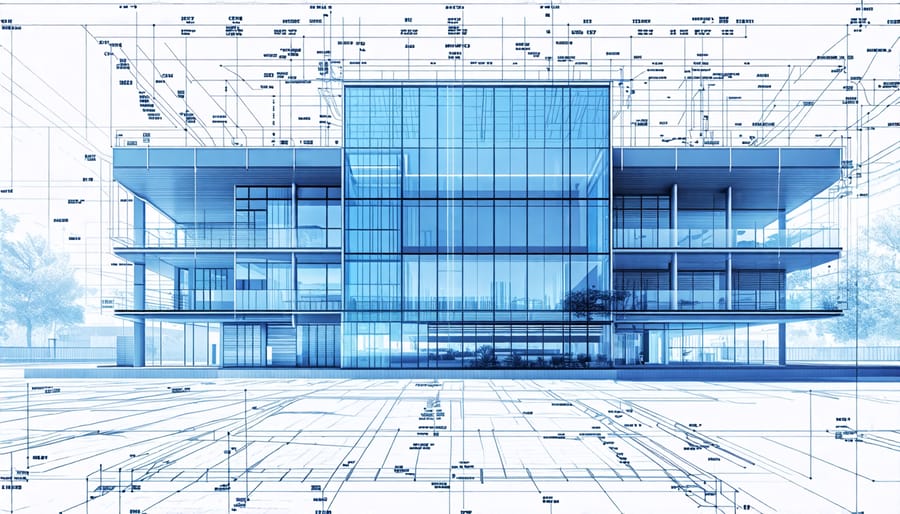Streamline project efficiency with construction drawing management software by integrating cloud-based platforms to securely store and access digital blueprints anywhere. Facilitate seamless collaboration across teams by implementing real-time updates and version control for all stakeholders. Optimize your workflow by automating document distribution, ensuring each team member receives the latest plans and revisions instantly. Enhance project accuracy and reduce errors through comprehensive annotation tools, allowing architects, engineers, and project managers to precisely communicate changes.
Key Features and Benefits

Enhanced Collaboration
Construction drawing management software significantly enhances collaboration among project stakeholders—architects, engineers, contractors, and project managers—by centralizing all drawings and documents in an accessible digital hub. This tool serves as a single source of truth, ensuring that everyone involved is working from the most current plans and revisions. Enhanced version control functions prevent unauthorized changes and outdated information from circulating, thereby reducing errors and costly rework. Through real-time updates and alerts, team members are notified immediately of modifications, fostering responsive and informed discussions.
Furthermore, these platforms integrate communication tools such as annotations, comments, and task assignments directly within the drawings, streamlining interaction and decision-making processes. By connecting dispersed teams, onsite and in-office professionals can collaborate efficiently, save time, and maintain project momentum. Expert testimonials and case studies underscore that these software solutions not only improve communication but also drive coordination efficiency, leading to successful project delivery. Enhanced collaboration ultimately translates into quantifiable improvements in project management and overall productivity within the construction industry.
Efficient Version Control
Efficient version control in construction drawing management software is crucial for minimizing errors and avoiding costly rework. By maintaining a single, accessible repository of design documents, construction professionals can ensure that all stakeholders are working from the most up-to-date plans. This streamlined approach not only enhances communication among project teams but also reduces the risk of discrepancies that often lead to misunderstandings and construction delays. The software provides automatic updates and notifications, allowing team members to track changes in real-time and confirm that necessary adjustments are made promptly. This capability to efficiently manage versions is transformative, as it allows architects, engineers, and project managers to leverage construction data effectively in their decision-making process. Furthermore, powerful version control features enable quick retrieval of past document versions for audits or legal compliance checks, ensuring that project documentation is both transparent and reliable. By reducing the incidence of errors and fostering better collaboration, construction drawing management software significantly enhances project efficiency and confidence in delivering successful outcomes.

Accessibility and Security
Construction drawing management software prioritizes accessibility and security, ensuring authorized users can easily access essential drawings while protecting sensitive data. By utilizing cloud-based platforms, these tools allow project teams, including architects and engineers, to access drawings remotely, streamlining collaboration regardless of location. Advanced permission settings control who can view or modify files, ensuring that only authorized personnel have access. Additionally, robust encryption protocols safeguard data against unauthorized access and potential breaches. Regular updates and backups further enhance security, ensuring data integrity and continuity. This combination of security and accessibility supports efficient project management and minimizes delays, ultimately contributing to successful project outcomes.
Industry Implementations: Real-World Examples
Case Study 1: Large-Scale Infrastructure Project
In a significant infrastructure project in the heart of a bustling metropolis, construction drawing management software played a pivotal role. This large-scale endeavor, which involved constructing a massive transport hub, required coordinating thousands of documents and drawings. The software facilitated seamless collaboration among a diverse team of architects, engineers, and construction professionals, ensuring real-time access to the most current plans across the board. By integrating and organizing construction drawings, the software eliminated costly errors and redundancies, significantly enhancing project efficiency. One senior project manager noted, “The ability to instantly share updates and synchronize revisions was a game-changer, reducing our timeline considerably.” Furthermore, the software enabled robust version control and document tracking, mitigating risks associated with outdated information. By harnessing cloud technology, it ensured data security and accessibility from any location. This case exemplifies how construction drawing management software not only improved workflow but also set a new standard for future infrastructure projects.

Case Study 2: Sustainable Building Development
In a recent breakthrough project focused on sustainable building development, a leading architectural firm adopted construction drawing management software to significant effect. By leveraging this technology, the firm was able to streamline collaboration, reduce material waste, and optimize design accuracy, ultimately contributing to reducing emissions. The software’s advanced features facilitated real-time updates and document accessibility, leading to a seamless integration of eco-friendly design principles and efficient construction practices. Insights from project managers highlight how the software enabled precise tracking of green materials usage and adherence to environmental standards. This not only shortened the project timeline but also minimized the carbon footprint, setting a new benchmark for sustainable construction. Engineers noted that the enhanced data sharing capabilities allowed for a more calculated approach to material selection, supporting the overall sustainability goals. This case study vividly illustrates the tangible environmental benefits that construction drawing management software brings to ambitious, environmentally-responsible building projects.
Overcoming Common Challenges
Integration with Existing Systems
Integrating construction drawing management software into existing workflows requires a strategic approach to maximize its potential and enhance project efficiency. Begin by conducting a comprehensive assessment of your current systems to identify compatibility issues. This helps in selecting software that seamlessly integrates without disrupting existing processes. Engage key stakeholders early, including architects, engineers, and project managers, to gain insights into their specific needs and ensure the chosen software aligns with their requirements. Training sessions tailored to different user levels can facilitate smoother transitions and promote user adoption.
Consider incremental implementation, starting with pilot projects, to test the software’s effectiveness and make necessary adjustments. Establish open communication channels among all teams to report integration challenges and explore solutions collaboratively. Leverage data from expert interviews and case studies to draw parallels with similar successful integrations within the industry. This approach not only minimizes potential disruptions but also enhances the software’s utility across various stages of the construction process, ultimately leading to improved coordination and productivity.
Training and Adoption
To ensure successful adoption and training of staff on construction drawing management software, it’s essential to adopt a structured approach tailored to your team’s needs. Start by identifying key stakeholders and involve them early in the decision-making process. Their insights can guide customization and implementation strategies that align with existing workflows. Leverage expert interviews and in-depth case studies to understand best practices and potential pitfalls from similar organizations.
Develop a comprehensive training program that accommodates various learning styles, offering a mix of hands-on workshops, online tutorials, and one-on-one sessions. Ensure that all staff, from architects to project managers, are familiar with the software’s capabilities and can apply them effectively. Utilize internal champions—experienced staff who can support their peers and encourage engagement.
Gradual integration can prevent disruption; consider a phased rollout with feedback loops to refine processes. Encouraging open communication throughout the transition allows for responsive adjustments, thereby increasing confidence and proficiency among users. Finally, measure adoption success with specific KPIs to track improvements in efficiency and collaboration, ensuring the software delivers its intended value.
Future Trends in Construction Drawing Management
In the evolving landscape of construction drawing management, several trends and technological advancements are shaping the future of this critical software category. One key trend is the integration of Building Information Modeling (BIM) with construction drawing software, enhancing collaboration and efficiency across multifaceted projects. BIM provides a comprehensive 3D model that significantly improves the accuracy of construction drawings, allowing architects and engineers to make data-driven decisions swiftly.
Furthermore, cloud-based platforms are gaining traction as they offer real-time access to drawings, ensuring that all stakeholders have up-to-date information, minimizing errors and rework. This accessibility enables seamless collaboration among geographically dispersed teams, boosting project efficiency. Alongside these, the incorporation of artificial intelligence (AI) and machine learning is introducing predictive analytics into construction drawing management. AI-powered tools can analyze historical data to predict potential design issues before they occur, reducing delays and cost overruns.
Another promising development is the use of augmented reality (AR) and virtual reality (VR), allowing professionals to visualize and interact with construction drawings in a virtual environment. This immersive experience enhances the understanding of complex designs and supports better planning and communication. As construction projects continue to grow in complexity, embracing these innovations can significantly enhance productivity and streamline construction processes, offering a competitive edge to industry leaders.
Conclusion: Embracing Change in Construction Management
In the dynamic and ever-evolving landscape of construction, embracing change has never been more crucial. The adoption of construction drawing management software stands at the forefront of this transformation, offering numerous advantages that are reshaping industry practices. This technology streamlines project coordination by providing real-time access to updated drawings, thus enhancing communication among architects, engineers, and project managers. The digital integration of workflows minimizes manual errors and boosts overall efficiency, allowing teams to focus on strategic tasks rather than administrative details.
Moreover, construction drawing management software plays a pivotal role in sustainability efforts, reducing paper use and promoting digital documentation. Its data analytics capabilities enable more accurate resource planning and allocation, ensuring projects are completed on time and within budget. As we look to the future trends in construction technology, it becomes evident that those who adopt these tools will lead in innovation and competitiveness.
Construction professionals and decision-makers must recognize the potential of this technology to enhance productivity and drive growth. By embracing these advancements, the industry not only adapts to modern demands but also crafts a foundation for future successes. The journey towards digitized construction management is not just an option—it’s a necessity for thriving in a rapidly changing world.

